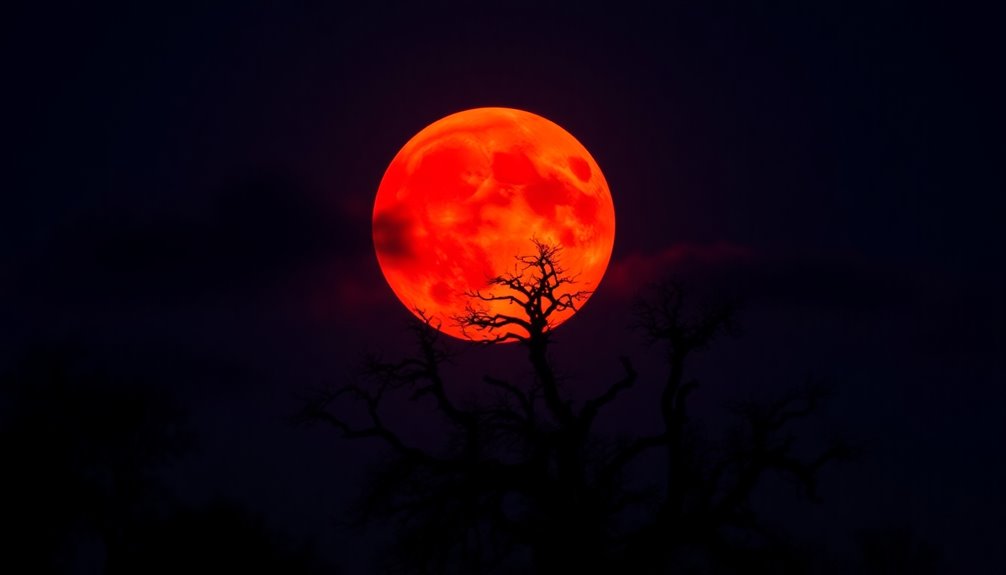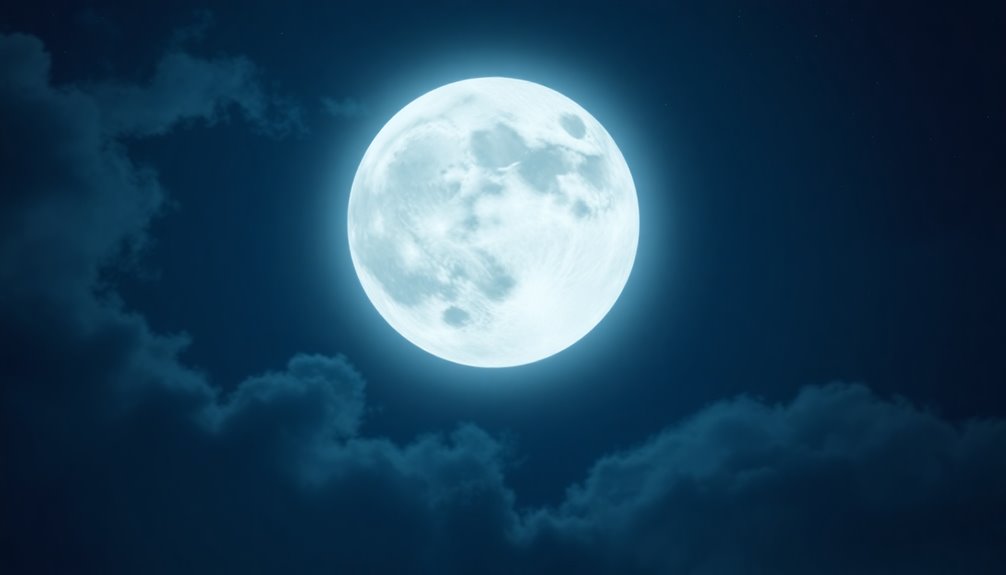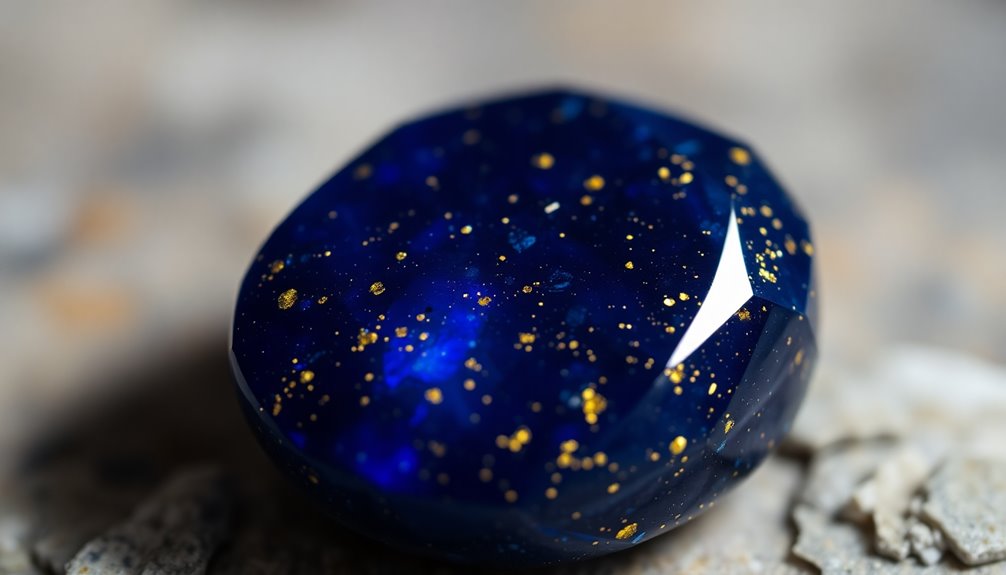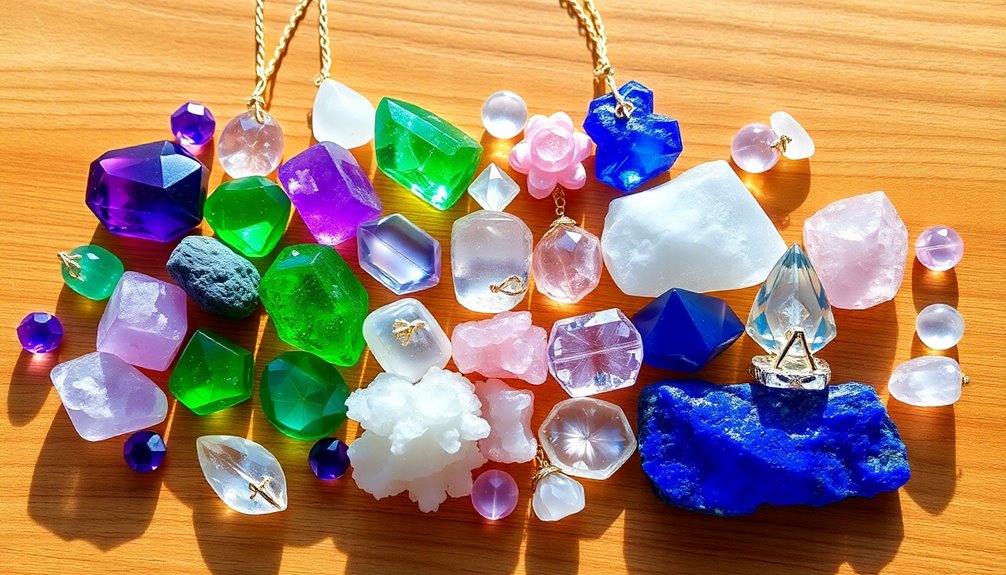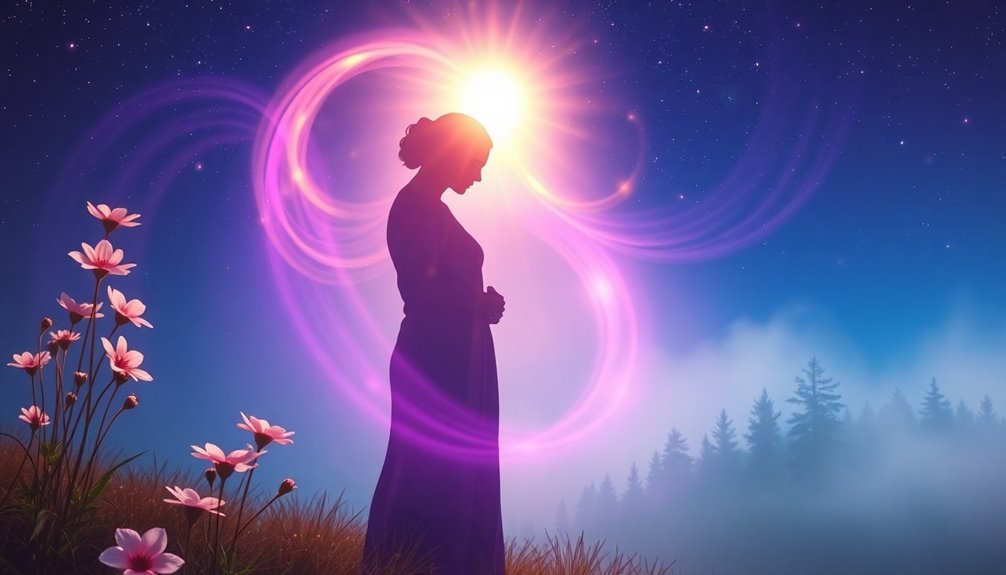Moonstone is a powerful crystal that enhances your intuition and emotional balance. Its unique connection to lunar energy helps you navigate life's emotional fluctuations with calmness and clarity. This stone, often called the "Stone of New Beginnings," supports emotional healing and personal growth, making it easier for you to make sound decisions during times of change. Additionally, Moonstone encourages improved relationships and fosters emotional stability. Wear Moonstone jewelry to absorb its energies or incorporate it into your personal rituals for enhanced intuition. There's much more to uncover about Moonstone's benefits and uses, so keep exploring!
Key Takeaways
- Moonstone promotes emotional balance, providing calmness and clarity during life's changes and challenges.
- Enhances intuition and psychic abilities, aiding in navigating emotional fluctuations and decision-making.
- Deeply connected to lunar and feminine energies, fostering personal growth and emotional healing.
- Regulates menstrual cycles and eases PMS symptoms, contributing to overall hormonal balance and wellbeing.
- Wearing or using Moonstone in rituals can enhance emotional stability and strengthen relationships.
Overview of Moonstone

Moonstone is an enchanting crystal that stands out for its unique adularescence, which creates a shimmering effect that resembles moonlight. This enthralling stone, available in shades like white, cream, peach, and blue, is often referred to as the "Stone of New Beginnings."
Its deep connection to lunar energy and feminine energy makes it a powerful ally in your journey of emotional healing and personal growth.
When you work with Moonstone, you'll find it enhances your intuition and psychic abilities, helping you to navigate emotional fluctuations with ease. This crystal promotes emotional balance, supporting you during changes and transformations.
If you're sensitive to shifts in your feelings, Moonstone can provide the calmness and clarity you need to stay grounded.
Many people incorporate Moonstone into their healing practices, as it's believed to enhance overall physical, mental, and spiritual well-being.
By embracing the energy of this remarkable stone, you open yourself up to new possibilities and personal growth.
Historical and Cultural Importance

Moonstone has held a special place in various cultures for centuries, often revered for its connection to lunar deities.
You'll find that in Ancient Rome and Greece, it symbolized mystical properties, while in Hindu culture, it's commonly given as a wedding gift to signify love.
This crystal's historical significance not only highlights its protective attributes but also underscores its role in rituals centered around fertility and emotional balance.
Ancient Cultural Reverence
Cherished for centuries, Moonstone holds a significant place in various cultures, particularly in Ancient Rome and Greece, where it was linked to lunar deities and deemed to have mystical qualities. Its emotional and intuitive healing properties have made it a favorite among ancient civilizations.
- Symbol of Femininity: Moonstone is revered as a talisman for fertility and love, reflecting its deep-rooted significance in women's traditions.
- Gift of New Beginnings: In Hindu culture, it's often given as a wedding gift, symbolizing love and new beginnings.
- Protector of Travelers: Ancient civilizations believed that Moonstone safeguarded travelers during their journeys, enhancing their intuition along the way.
Today, the cultural importance of Moonstone continues to thrive. You'll find it frequently used in spiritual practices and meditation, promoting emotional balance and inner peace.
This stone not only connects you to your feminine energy but also serves as a reminder of its historical significance in nurturing love and protection. Embracing Moonstone can deepen your appreciation for its past while enhancing your emotional well-being in the present.
Lunar Deities Connection
Throughout history, the connection between Moonstone and lunar deities has shaped its revered status across various cultures. In ancient Roman and Greek civilizations, Moonstone was closely associated with lunar deities, believed to embody the essence of the moon itself. This sacred gemstone was often used as an offering to lunar goddesses, reflecting its significant role in rituals aimed at invoking Goddess energy.
Hindu culture also regards Moonstone as a sacred gemstone, symbolizing love and emotional harmony. It's no surprise that many ancient civilizations saw it as a powerful tool for enhancing emotional balance and promoting healing powers.
Travelers carried Moonstone for its protective qualities, believing it safeguarded them on their journeys while also helping them align their energies with the moon's rhythms.
This deep-rooted connection to lunar cycles highlights the historical significance of Moonstone, not just as a beautiful crystal, but as an essential part of spiritual practices.
Whether you're drawn to it for its aesthetic appeal or its rich history, embracing Moonstone can enhance your intuitive abilities and emotional well-being, linking you to the ancient reverence for lunar deities.
Wedding Gift Tradition
The tradition of gifting Moonstone at weddings carries deep historical and cultural significance, particularly in Hindu customs where it's seen as a sacred stone. This enchanting gem symbolizes love, harmony, and emotional balance between partners, making it a perfect wedding gift for couples starting their journey together.
Here are three key reasons why Moonstone is a meaningful choice:
- Emotional Stability: Moonstone's calming properties foster emotional stability, which is essential for a successful marriage.
- Divine Feminine Energy: The stone represents new beginnings and embodies divine feminine energy, promoting understanding and compassion between partners.
- Connection to Lunar Cycles: Gifting Moonstone enhances the couple's connection to the lunar cycles, aligning their emotional energies for a harmonious relationship.
Historically, ancient Romans and Greeks also associated Moonstone with lunar deities, believing it brought good fortune and protection to couples.
Emotional and Astrological Benefits

Moonstone is powerful for enhancing your intuition and emotional clarity, making it a go-to crystal during times of change.
Its calming energy fosters emotional stability, helping you navigate life's ups and downs with grace.
For those aligned with the Cancer zodiac, this crystal's nurturing properties resonate deeply, supporting your inherent emotional depth.
Enhancing Intuition and Clarity
Many people turn to Moonstone for its remarkable ability to enhance intuition and clarity, especially during times of emotional turbulence. This stone's gentle, nurturing energy helps you manage emotional fluctuations, promoting inner peace and facilitating healing.
By connecting with your third eye and crown chakras, Moonstone fosters spiritual awareness, enabling you to gain deeper insights into your experiences.
Here are three key ways Moonstone can enhance your intuition and clarity:
- Emotional Balance: By analyzing negative energies, Moonstone helps you achieve emotional equilibrium, making it easier to respond to life's challenges with clarity.
- Improved Decision-Making: Many users report that Moonstone aids in making sound decisions during times of uncertainty, allowing you to trust your instincts.
- Enhanced Spiritual Awareness: As you embrace Moonstone's energy, you may find yourself more attuned to the subtle messages of the universe, sharpening your intuitive abilities.
Embracing Moonstone can be a transformative experience, guiding you towards greater emotional clarity and heightened intuition. Additionally, incorporating techniques from the Law of Attraction can further amplify your connection to Moonstone's energy.
Whether you're managing a difficult phase or seeking personal growth, this crystal can support you on your journey.
Emotional Stability and Balance
During times of emotional upheaval, finding stability can feel overwhelming, but harnessing the power of Moonstone can be a game changer. This beautiful crystal is renowned for its ability to enhance emotional stability, making it especially beneficial if you're sensitive to emotional turmoil or steering through life's changes. Its gentle energy calms turbulent feelings, reduces aggression, and promotes mental stability during challenging times.
In Vedic astrology, Moonstone strengthens intuition and emotional clarity, helping you traverse your emotional landscape with ease. Many users report emotional healing and improved relationships due to Moonstone's nurturing influence, which encourages love and connection. Particularly for Cancer zodiac signs, it aligns emotions with lunar cycles for enhanced well-being.
Here's a quick overview of Moonstone's benefits for emotional stability:
| Benefit | Description |
|---|---|
| Emotional Balance | Calms feelings and promotes mental stability |
| Intuition Enhancement | Strengthens emotional clarity and insight |
| Relationship Improvement | Fosters love and connection with others |
| Support in Changes | Aids in steering through life's changes |
| Lunar Cycle Alignment | Resonates with the moon for emotional well-being |
Embrace Moonstone to cultivate your emotional stability and balance.
Astrological Significance and Alignment
The connection between Moonstone and astrology adds another layer to its benefits, particularly for those attuned to their emotional and spiritual well-being.
Moonstone is said to resonate deeply with the lunar cycles, enhancing intuition and emotional stability, especially for individuals born under the Cancer and Pisces zodiac signs. This crystal acts as a supportive ally during personal transformations, helping you navigate emotional fluctuations with grace.
Here are three key astrological benefits of Moonstone:
- Enhanced Emotional Insights: Moonstone amplifies your ability to tune into your feelings, providing clarity during times of emotional upheaval.
- Strengthened Relationships: Its nurturing energy fosters deeper connections, enhancing understanding and empathy in your relationships.
- Alignment with Inner Wisdom: By aligning with lunar cycles, Moonstone encourages reflection, allowing you to make informed decisions based on your inner wisdom.
Utilizing Moonstone can remarkably improve your emotional intelligence, making it easier to embrace changes and maintain balance in your life.
Whether you're experiencing a transformation or seeking to deepen your relationships, this crystal offers invaluable astrological significance that supports your journey.
Health and Wellbeing Effects
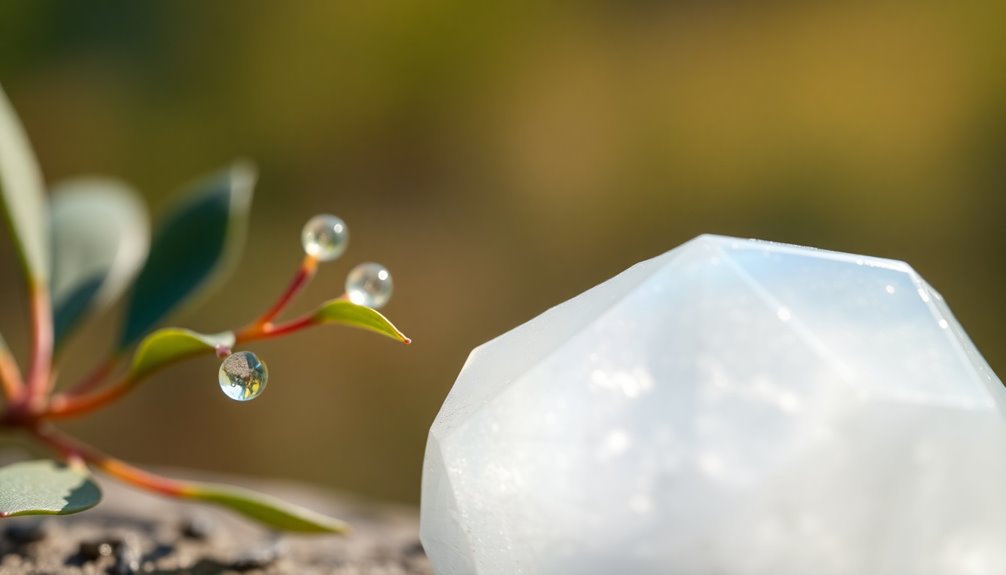
Moonstone is often regarded as a powerful ally for health and wellbeing, particularly when it comes to reproductive health. This crystal helps regulate menstrual cycles and ease PMS symptoms, making it especially beneficial for women. By enhancing hormone balance, Moonstone can also aid in fertility issues and alleviate discomfort during pregnancy.
In addition to its reproductive benefits, Moonstone plays a significant role in reducing stress and anxiety. Its calming energy helps you unwind, fostering a sense of tranquility that can alleviate stress-related ailments like headaches and muscle tension.
By promoting restful sleep, Moonstone improves your overall wellbeing, allowing you to wake up refreshed and rejuvenated.
Moreover, the crystal is known to enhance emotional connections in relationships, promoting harmony and emotional stability. By tapping into the moon's energy, you can deepen your intuition and psychic abilities, which further enriches your emotional understanding.
Incorporating Moonstone into your life not only supports your physical health but also nurtures your emotional wellbeing, creating a balanced and harmonious existence. Embrace Moonstone's healing properties, and experience the transformative effects it can have on your health and wellbeing.
Everyday Uses of Moonstone
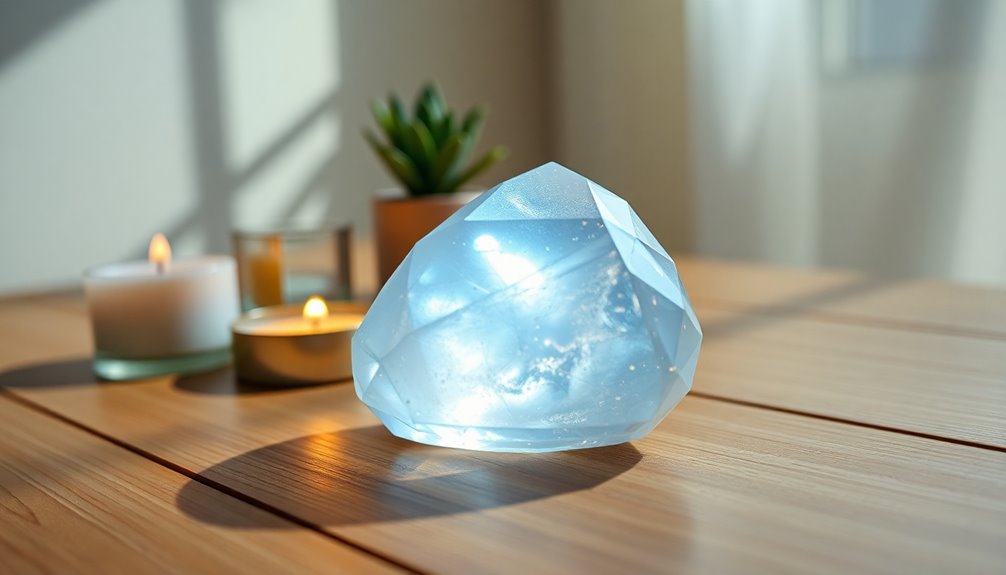
Incorporating Moonstone into your daily routine can transform the way you experience life. This beautiful crystal offers numerous everyday uses that promote emotional balance and enhance intuition.
Here are three effective ways to integrate Moonstone into your life:
- Wearing Moonstone: Adorn yourself with Moonstone jewelry, like necklaces or bracelets. This allows for continuous energy absorption, maximizing its calming effects and promoting tranquility throughout the day.
- Personal Rituals: Utilize Moonstone in your personal rituals to reflect on your emotions. Align your intentions with lunar cycles, empowering yourself during changes and emotional shifts.
- Pocket Stone: Carry Moonstone as a pocket stone for on-the-go support. Whenever stress or anxiety arises, simply hold it to help mitigate those feelings and restore emotional balance.
Care and Maintenance Tips
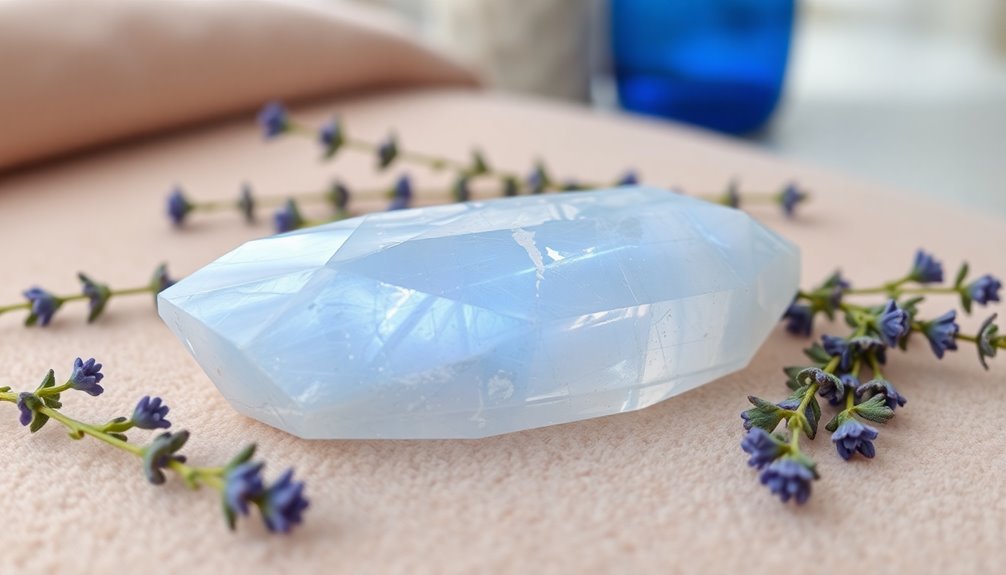
Caring for your Moonstone guarantees it retains its beauty and healing properties. To keep it in prime condition, gently clean your Moonstone with mild soap and water, avoiding harsh chemicals that could damage its surface.
Regular cleansing is essential to maintain its healing properties—consider running it under water, smudging it with sage, or placing it in moonlight to recharge.
When you store your Moonstone, always keep it separate from other gemstones to prevent scratching. Using protective settings for jewelry can also help maintain its integrity.
If you want to charge your Moonstone, place it on a windowsill under moonlight or surround it with Selenite or Clear Quartz for maximum energy.
Be mindful of temperature and humidity changes; avoid exposing your Moonstone to extreme conditions, as this can compromise its structure.
By following these care and maintenance tips, you'll guarantee your Moonstone remains a powerful ally for emotional balance and intuitive insight.
Frequently Asked Questions
Does Moonstone Help With Intuition?
Yes, Moonstone can help with your intuition. When you carry or wear it, you might notice a deeper connection to your inner wisdom.
Its calming energy can clear your mind, making it easier to access those intuitive feelings, especially during emotional turmoil.
If you meditate with Moonstone, you could find it enhances your ability to receive intuitive messages, guiding you toward better decisions.
Trust in its gentle support to boost your intuitive capabilities.
Does Moonstone Balance Emotions?
Can you imagine feeling more balanced in your emotions? Moonstone can help with that.
It's known for soothing emotional turmoil and promoting inner peace, especially during tough times. By calming aggressive feelings and fostering mental stability, you'll find it easier to navigate emotional ups and downs.
Plus, its connection to lunar cycles aligns your emotional states with natural rhythms, making it a supportive ally during life changes.
You'll feel more centered and at peace.
What Are the Main Benefits of Moonstone?
Moonstone offers several benefits that can enhance your life. It boosts your intuition and psychic abilities, helping you gain clarity in your decisions.
You'll find that it promotes emotional balance, soothing your emotional ups and downs, especially during changes. This stone also supports reproductive health, easing PMS symptoms and fostering fertility.
Plus, it strengthens relationships, nurturing emotional connections, and providing inner peace, making it a great companion for reducing stress and promoting restful sleep.
What Crystals Are Good for Emotional Balance?
Have you ever felt overwhelmed by your emotions, wondering how to find balance? Crystals can help.
Amethyst calms your mind, reducing anxiety, while Rose Quartz nurtures self-love and harmony in relationships.
Lepidolite's lithium content can alleviate mood swings, offering tranquility. Citrine boosts your confidence, helping you shake off negativity, and Black Tourmaline absorbs harmful energies, grounding you emotionally.
Each crystal serves as a powerful ally in your journey towards emotional stability.
Conclusion
Incorporating moonstone into your life can be like opening a door to your inner self, inviting intuition and emotional balance to flow in. Whether you wear it as jewelry, keep it in your space, or meditate with it, this enchanting crystal can enhance your well-being. So, embrace its calming energy, and let moonstone guide you on your journey to self-discovery and harmony. Your spirit will thank you for it!


